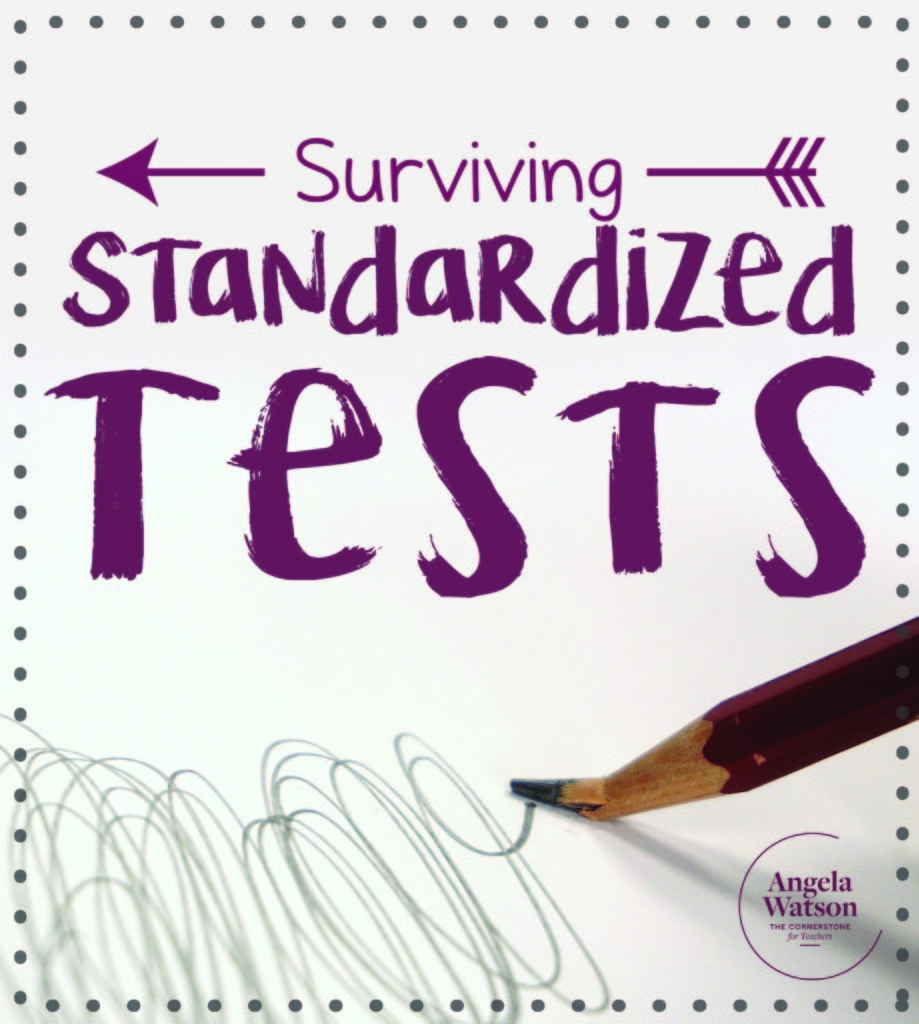One of the most stressful components of 21st century schooling is the ubiquity of standardized testing. This page (which is adapted from The Cornerstone book) will help you prepare your students without sacrificing authentic learning. You’ll also discover ideas to take the pressure off kids during the week(s) of testing and add some fun diversions to help students relax and de-stress.

The stress of testing
Managing a classroom full of students who are stressed out about standardized testing requires special considerations. I know of children who have gone on anti-anxiety medications, vomited the day of the test, started shaking and crying uncontrollably, and refused to go to school because they were so worried about how they would do.
Preparation for state testing can be extremely stressful for teachers and students. In some schools, children are constantly drilled, while in others, the emphasis is on authentic instruction as much as possible. Regardless of the expectations in your school, students do need to learn the skills that are assessed on state tests, and you’ll need to address the issues that come with having high stakes testing. Chapter 22 of The Cornerstone book will help you explain the testing situation to your students and build their self-confidence so that the process is as painless as possible. I’ll also explain ways that I prepare children academically for state testing without sacrificing meaningful and developmentally appropriate instruction. The following is an excerpt from the first part of the chapter.
Preparing psychologically: “Why are we doing this?”
Have a class meeting about WHY students have to take so many tests.
Ask what is a test, anyway, and why do teachers give so many of them? Take the children’s ideas first, and guide students to understand that teachers use test results to guide future instruction. In the case of standardized tests, the community and government want to make sure that kids are learning and that teachers are all doing what they need to do to help. Explain that when people notice areas in which kids don’t do well, the teachers will realize there is a problem and help children make improvements.
Set a purpose for test-taking.
Students should understand why they are learning things in school and how the information will be useful to them in the future. This is especially true for standardized testing, because it’s difficult for students to see the relevance to their everyday lives. Try to help students make real-world connections as often as possible.
Explain test-related vocabulary and scoring criteria.
I discuss with my class why the tests are called ‘standardized’ (it’s similar to standardized measurement units—everyone uses the same tools so it’s easy to make fair comparisons). It’s important to make clear any other test-related vocabulary the kids don’t understand. Many of the words are too large for them to really grasp, but since kids are the ones who have to take the tests, I think they should be taught to understand our conversations about them. I also explain the scoring criteria so that the children know what they will be working towards.
Put the test into perspective using the context of other assignments.
Students don’t always understand the weight that high stakes tests hold. I explain that these are the assessments seen by parents, principals, superintendents, the governor, sometimes even the president. These are the most important assignments and it is crucial to give them your greatest effort. I explain to my kids that the test scores will be published on the Internet, in the local newspapers, and so on. I stress that we want the community to know how hard we have worked and to be proud of us.
I do try to discuss this in the context of how it is important to do our best work on every task that is given to us in life for the satisfaction of a job well done. More often than not, a student will bring this point up, making a much bigger impact than if I had mentioned it myself.
We also talk about standardized tests in relation to other work. We discuss the purpose of homework and class work (to practice skills); quizzes (to check what students know prior to testing them); classroom tests (to prove what students know and can do independently); benchmark tests (for the school district to check and track progress), and standardized tests (to find out how well students are doing in relation to other children in the school, county, and state, and to make sure they are ready to go to the next grade level). I give examples of each type of assignment to make the concepts more concrete.
Don’t be afraid to express your own feelings about the test.
It’s often reassuring for kids to see that even grown-ups have to deal with testing pressure! You can be an excellent role model for handling stress. I tell my kids that most teachers don’t like giving the FCAT (our state standardized test in Florida), and most kids don’t like taking it, but the test is something that we have to do, so we should stick together and do the best we can.
Make a conscious effort to reduce test anxiety.
This is much easier to do in states that don’t require mandatory retention when children fail standardized tests. In those places, you can assure kids that only their attendance and report card grades will determine whether they are promoted, and discuss other motivations they should have for doing well on the test.
In states that do tie test performance to promotion, it’s even more critical to put kids at ease, because anxiety can cause them to do worse. I try not to mention the test very often, other than in the context of preparation as a means to build student confidence. For example, I’ll say, “This reading assignment has a lot of FCAT-style questions. This is going to be great practice, because when you see the actual test, you’ll already know what it’s going to look like! There won’t be any surprises!” I’ll also make comments such as, “You did so well on your geometry assignment! When you have to identify solid figures on the FCAT, it will be no problem for you! You are really working hard!”
Preparing academically: “Will this be on the test?”
Chapter 22 of the book goes on to explore each of the following points in detail:
- Regulate the amount of materials you use that are formatted to look like standardized tests.
- When you do give test-prep work, approach the whole thing nonchalantly and build up students’ confidence.
- Practice assessing anonymous work samples as a class.
- Teach test-taking skills and provide timed practice.
- Give as much feedback as possible on practice tests.
- Stop doing practice activities a week before the test.
During the test: “Can we take a break now?”
Next, the chapter delves into:
- The importance of pep talks (especially individual ones) cannot be overestimated!
- Have kids make test affirmation posters and read them aloud regularly.
- Take all the test breaks that are allowed, and find quiet activities for children to do during them.
After the test: “Is it over now?”
The chapter continues with three points about post-testing:
- Have a celebration!
- Don’t try to teach any new material the rest of testing week.
- Take time for yourself to relax and de-stress.
Chapter 22 of The Cornerstone book also provides more great ideas for coping with standardized testing:
- De-stressing ideas for test breaks: games and activities to help kids relax and re-focus
- Making test week the highlight of the year: a variety of ideas from website visitors on making testing special and fun
- The importance of choosing a school and district with responsible views towards testing: what successful schools have in common
There is nothing wrong in having standards, if standards are used as banks of information giving a sense of important components that make up a discipline. When local systems are able to use standards as guidelines or identifiers of important things to know for children’s learning, they can be useful. The tragedy of standards is when people use them as weapons to exercise their authority. There is no historical precedent in American education where authoritarian approaches from the outside have raised the quality of education.
–The Energy To Teach by Donald Graves

Angela Watson
Founder and Writer
Sign up to get new Truth for Teachers articles in your inbox
OR

Join our
community
of educators
If you are a teacher who is interested in contributing to the Truth for Teachers website, please click here for more information.

















